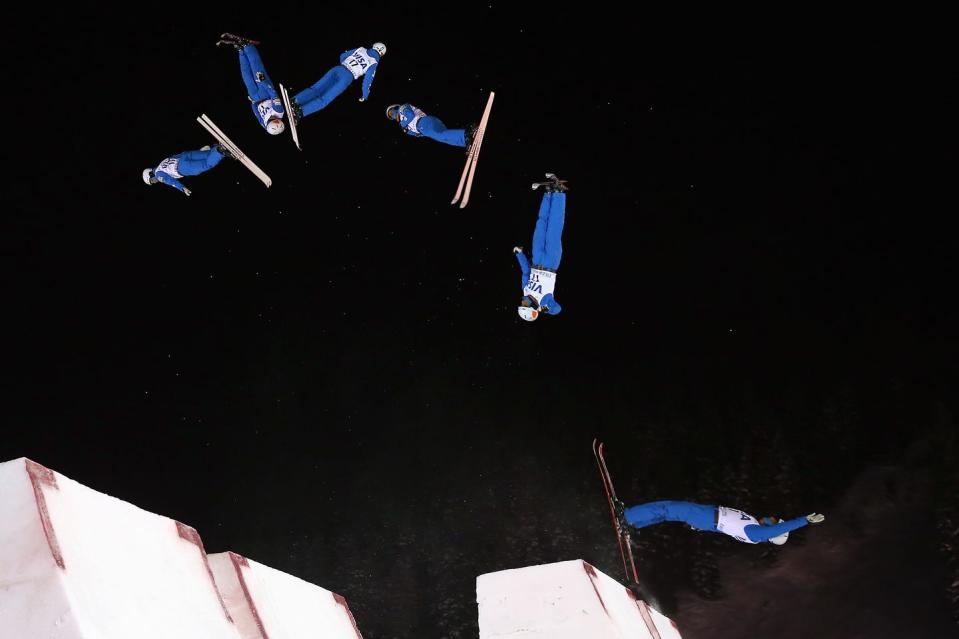What It Feels Like To Be an Olympic Aerial Skier

Picture it: You fly down a hill at 45-miles-per-hour, take off from a four-meter jump, and casually churn out four full rotations and three backflips. Your body stays perfectly straight and you maintain a perfectly symmetrical, high-altitude arc in the air before landing with a not gentle crunch to the spine and knees.
That's what it takes to win Olympic gold in aerials skiing, a beautiful, insane, frenetic, and dangerous sport that none of us are watching.
There's no contorting and twisting down a halfpipe or streaking through a mogul field in aerials. All the action is contained to one jump per heat, a blip on the screen and a blip on NBC’s coverage every four years.
“You get one shot to pull it off or crash and go home,” said Jon Lillis, 2017 World Champion, top-ranked aerialist on Team USA, thrill-seeking maniac.

For Lillis and the other skiers, landing triple backflips with two or three twists (child's play, really) should get them through qualifications. But in the final rounds, landing the quadruple-twisting triple back flip, also known as “The Daddy” (because what else would you call it?), will win gold.
Oh, and "some of us might add a fifth rotation," Lillis told me. "That is if we make it to the last round." He's insane for saying this. They’d have to spin so fast they couldn't spot a landing and just pray to whatever god watches over snow sports that it goes well and either end up with either a medal or a brace around their neck.
Here Lillis walks us through what goes into this feat and why the risks are higher than ever in Pyeongchang.
Speed Check
Before launching himself off the jump, Lillis does a speed check. He skis down the hill and cuts away from the jump at the last-second. His speed should hover between 45 and 50 miles-per-hour. Coaches take into account any crosswinds to figure out how how high up the hill to start the run.
Wind is paramount in aerials - imagine if gymnasts or divers had to reckon with swirling crosswinds when they compete. And in Pyeongchang, the weather has not cooperated. Authorities have delayed events and evacuated facilities because of excessive wind. But know this, aerialists can (and will) compete amidst high winds. Last month, Jon’s brother, Chris, who's also a World Cup champion, was thrown off by a 45-miles-per-hour crosswind at an event in China. The crash fractured his leg and tore his ACL.

Takeoff
After one last visualization - feet together, stay straight, spot the landing - Lillis buckles his boots, fist bumps his coach, and looks to his other coach at the ramp, who monitors wind speeds at the bottom. When he gets the all clear, he points his skis down the hill and gravity pushes him down. As he approaches the ramp, he puts his arms up and then launches himself off the lip.
Flight
He throws his head and right hand to the left and flips once and twists once, then flips again and twists twice more. He tops out at over 50 feet in the air. Stay tight, stay straight, he tells himself. He switches from ascent to free fall - "the moment is like pure weightlessness," he says - and he hears his coach scream, “Reach for the landing!” With one flip and one full rotation left on descent, he spots the ground.
Landing
A clean landing happens as often as a gnarly one, especially when the snow is more like an ice block. The feels-like temperatures have gone as low as -21 degrees this week in Pyeongchang, which will make for even harsher landings.
Even if Lillis and company don't go for that fifth rotation, expect crashes. A “slap back” is the most common: athletes land with their weight back and their backsides literally slap against the snow. If their weight is forward, they’ll flip - it's called a “punch front.” If they come down sideways or not on top of their four-inch-wide skis at all, things go bad: “fractured legs and shoulders, cracked spines, torn ligaments, and concussions, I've seen it all," said Lillis.
Does a more exhilarating three-second thrill exist at the Games? Probably not. Just remember: don’t blink once Lillis takes off.
Aerials skiing qualification rounds start Saturday, February 17th.
You Might Also Like

